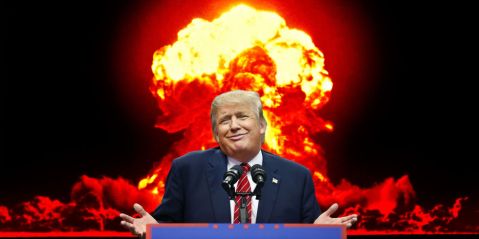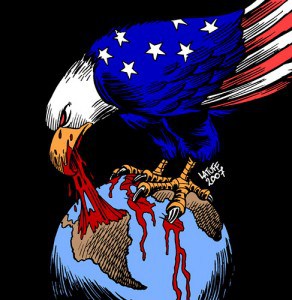Trump’s proposed hike in military spending likely to kick off new arms race

President Donald Trump this week proposed a $54 billion boost in U.S. military spending, representing a nearly 10 percent increase, to be funded by cuts to domestic spending and foreign aid. As the National Priorities Project points out, the proposed increase is more than the annual budgets of the Department of Homeland Security ($48 billion), Housing and Urban Development ($38 billion), Department of Energy ($30 billion), Department of Justice ($29 billion), and Department of State ($29 billion).
It is also well above the annual budgets of Environmental Protection Agency and National Science Foundation, which come in at $8 and $7 billion a piece. The Corporation for Public Broadcasting, in stark contrast, only receives $485 million a year and the National Endowment for the Arts just $148 million. “Domestic and foreign aid spending already account for less than half of the federal discretionary budget,” the National Priorities Project points out, while the Pentagon accounts for “more than half of the annual discretionary budget” at more than $600 billion a year.
Yet, President Trump proudly stated last night in an address to a joint session of Congress that he is pushing for the biggest military spending hike in generations. “I am sending the Congress a budget that rebuilds the military, eliminates the Defense sequester, and calls for one of the largest increases in national defense spending in American history,” he said. Of course, he failed to mention that the U.S. already spends about as much as the next 12 countries combined.

Trump’s proposed increase in military spending is part of a broader budget plan that includes massive cuts to the National Endowment for the Arts, the National Endowment for the Humanities and the Corporation for Public Broadcasting. So, basically, less Sesame Street, more war.
Besides questions of national priorities at a time when the country faces a host of problems on issues across the board – from crumbling infrastructure to the fact that more than 43 million people are living in poverty – the sharp increase in “defense” spending at a time of rising global instability and distrust likely means that other countries will feel compelled to follow suit in order to keep up.
Recalling the fact that Trump recently indicated his willingness to kick off a global arms race, actually stating in December 2016 “let it be an arms race” in response to criticisms of his flippant remarks about nuclear weapons, the military increases that he is now proposing should be understood as an opening salvo in what is sure to be a growing trend towards militarization and war.
 This is a troubling development by any standard, but for a country with as long a history of aggression and atrocities as the United States, it is even more worrying.
This is a troubling development by any standard, but for a country with as long a history of aggression and atrocities as the United States, it is even more worrying.
Notably, the U.S. has just been exposed for using depleted uranium munitions during air raids in Syria, despite a vow not to use the toxic, radioactive and legally ambiguous weapons in the battlefield. Foreign Policy magazine reported two weeks ago that Air Force A-10 attack planes fired more than 5,000 rounds of 30mm depleted uranium rounds during a pair of assaults on convoys in an ISIS-controlled part of eastern Syria in November 2015 despite the fact that the weapons have been linked to cancer and birth defects.
Trump’s budget proposals also come just after the release of a major report detailing trends in global military spending and arms transfers. The report by the Stockholm International Peace Research Institute (SIPRI) found that the volume of international transfers of major weapons has grown continuously since 2004 and increased by 8.4 per cent between 2012 and 2016. Notably, SIPRI found, “transfers of major weapons in 2012-16 reached their highest volume for any five-year period since the end of the cold war.”
The five biggest exporters – the United States, Russia, China, France and Germany – together accounted for 74 percent of the total volume of arms exports, while the U.S. alone accounted for a disproportionate one-third of the total. The lion’s share of its arms transfers went to the Middle East, fueling conflicts there in Syria, Yemen and Israel-Palestine, likely contributing significantly to the refugee crisis that is now destabilizing Europe.
As SIPRI reports:
With a one-third share of global arms exports, the USA was the top arms exporter in 2012–16. Its arms exports increased by 21 per cent compared with 2007–11. Almost half of its arms exports went to the Middle East.
‘The USA supplies major arms to at least 100 countries around the world—significantly more than any other supplier state’, said Dr Aude Fleurant, Director of the SIPRI Arms and Military Expenditure Programme. ‘Both advanced strike aircraft with cruise missiles and other precision-guided munitions and the latest generation air and missile defence systems account for a significant share of US arms exports.’
Not only is the United States fueling global conflict through its conventional military spending and arms sales around the world, but it is also potentially triggering a new nuclear arms race with the possibility of ending life on earth. This is at the same time that growing global efforts are being made to ban nuclear weapons once and for all with an ultimate goal of total nuclear disarmament.
As Trump recently told Reuters, “It would be wonderful, a dream would be that no country would have nukes, but if countries are going to have nukes, we’re going to be at the top of the pack.”
Yet, as Matthew Rosza recently pointed out, writing at Salon,
This statement seems to contradict New START, a strategic arms limitation treaty that requires America and Russia to have an equal number of strategic nuclear weapons for 10 years as of February 2018. It was reported by Reuters earlier this month that Trump denounced that treaty as a bad deal during a Jan. 28 conversation with Russian President Vladimir Putin.
The Ploughshares Fund, an anti-nuclear organization, noted however that “Donald Trump’s Plan to be Leader of the Nuclear Pack Is Nuts.”
“Scientists now calculate that as few as 100 nuclear weapons used in a war in South Asia would put enough smoke and particulates in the atmosphere to enshroud the Earth in a cloud for 2 to 3 years, dropping global temperatures about 2 to 3 degrees,” according to Ploughshares.
That, as it turns out, is enough to devastate most food crops in the world. The resulting famine could kill one billion people. The panic, global mass migrations, desperation and chaos would likely result in the end of nation states.
Make it a war with 200 or 300 nuclear weapons, and all that human beings have accomplished over the millennia would be wiped out. We would be well into Mad Max scenarios.
There are some 15,000 nuclear weapons in the world. The U.S. and Russia have almost 95 percent of them. That is much more than we need for any conceivable military mission. China, for example, only has about 260 weapons, yet that seems to do a pretty good job of deterring anyone from attacking them.
With these concerns in mind the United Nations is convening negotiations this month on “a legally binding instrument to prohibit nuclear weapons, leading towards their total elimination.” This new international agreement will place nuclear weapons on the same legal footing as other outlawed weapons of mass destruction, many of which the United States continues to use, manufacture and to supply to other countries, in blatant violation of international norms.

For more information on the nuclear ban negotiations, visit the International Campaign to Abolish Nuclear Weapons.

